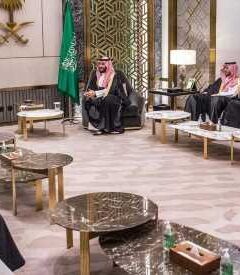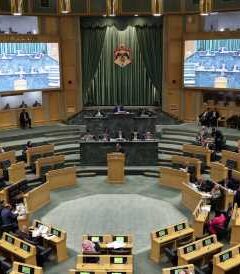Home » Middle East »
Trump Focuses on Defending Saudis, Not Striking Iran, for Now
WASHINGTON — President Trump is sending a modest deployment of American troops to Saudi Arabia and the United Arab Emirates, along with air and missile defense systems, in response to the attacks on Saudi oil facilities, which the administration blames on Iran.
Defense Secretary Mark T. Esper called the decision, which came on Friday during a White House meeting with top national security officials, “defensive in nature.” Defense Department officials said the Pentagon would deploy additional antimissile batteries to Saudi Arabia and might also deploy additional warplanes. The aircraft carrier Abraham Lincoln may extend its stay in the region as well, the officials said.
Gen. Joseph F. Dunford Jr., the chairman of the Joint Chiefs of Staff, said the precise number of American troops headed to the region had not been determined, but that it would be a “moderate deployment” in the hundreds, not thousands.
Mr. Trump had been weighing whether to take direct military action against Iran in response to the attacks on Saudi Arabia, which rattled global energy markets and which Secretary of State Mike Pompeo this week called “an act of war.”
At the White House on Friday, Mr. Trump boasted that he could order a retaliatory strike “in one minute,” and boasted equally that his current restraint should be seen as a sign of strength and toughness.
Although the administration is not ruling out military strikes, senior officials indicated that, for now, the president was content to remain within the parameters of defense, not offense. Pressed by reporters about whether the administration was still considering so-called kinetic action, or military strikes, Mr. Esper said, “That’s not where we are right now.”
A senior United States official estimated that additional American forces sent to the region would number in the low hundreds. At the Pentagon, the president’s decision was interpreted to be at the more restrained end of the spectrum of options, especially since American officials have expressed their increasing certainty in recent days that Iran was responsible for the attack.
Mr. Esper said Friday night that the Pentagon was now convinced that the attacks did not emanate in Yemen.
He also said that both Saudi Arabia and the United Arab Emirates asked for additional support from the United States this week.
The new deployment adds to the 2,000 troops the United States has deployed to the Middle East since June as a show of force following a series of Iranian provocations, including attacks on oil tankers in the Persian Gulf and the downing of an American surveillance drone off its coast. Roughly 500 of those troops have gone to Saudi Arabia.
Days after the American surveillance drone was shot down this summer, Mr. Trump approved a limited military strike on Iran — but on June 20 called off the operation at the last minute. Officials said that a covert cyberoperation was carried out instead.
Earlier Friday, Mr. Trump announced a new round of sanctions against Iran’s national bank, and the administration is said to be considering a range of additional actions, including more cyberattacks. And, at next week’s United Nations General Assembly meeting, Mr. Trump and Mr. Pompeo are expected to press for a diplomatic front against Iran, although many nations — including close allies — hold the administration accountable for rising tensions in the Persian Gulf region following Mr. Trump’s withdrawal from a nuclear deal with Iran.
In describing the new sanctions, Mr. Trump said the move constituted the “highest sanctions ever imposed on a country,” but analysts called it unlikely to inflict substantially more damage to an Iranian economy already suffering from an American economic chokehold.
On the one hand, Mr. Trump volunteered that the United States boasts a “totally renovated” military that includes “new nuclear,” adding, “The nuclear is at a level that it’s never been at before.” Mr. Trump said on Wednesday that he was not considering a nuclear strike on Iran, so it was unclear why he raised the subject of nuclear weapons again on Friday.
He also seemed to revel in his authority to launch a quick strike. Speaking to reporters in the Oval Office alongside the visiting prime minister of Australia, Scott Morrison, he said, “I could do it right here in front of you and that would be it.”
On the other hand, Mr. Trump complained that in 2016 he had been cast unfairly as a warmonger who was “going to blow everybody up.” He said that “people are very surprised” and “thrilled” that he has not employed the military against Iran. Responding to complaints that he has shown weakness in recent months by not responding to Iranian aggression with force, Mr. Trump retorted, “Actually, in my opinion, it shows strength.”
And while reiterating that it would be easy to deal Iran a crippling blow, he said, “I’m not looking to do that if I can.”
But he kept his options open. Speaking alongside Mr. Morrison at a news conference later in the day, Mr. Trump cautioned that he was not facing an imminent decision. “Plenty of time,” he said.
The Iranian foreign minister, Mohammad Javad Zarif, said on Thursday that a military strike against Iran by the United States or Saudi Arabia would result in “an all-out war.”
The latest sanctions affect the Central Bank of Iran and the National Development Fund of Iran, “the last remaining source of funds,” said Treasury Secretary Steven Mnuchin, who joined Mr. Trump in the Oval Office. “This is very big,” Mr. Mnuchin said.
Last year, the United States took the rare step to designate the head of the central bank, Valiollah Seif, as a global terrorist, and accused the bank of funneling money to Hezbollah.
In addition to sanctioning Mr. Seif last year, the Treasury Department reimposed sanctions related to purchases of American dollars by the Iranian government, which had been suspended as part the international nuclear accord.
The new sanctions to the central bank are an additional layer over what the United States has already levied, said Ryan Fayhee, a partner at Hughes Hubbard & Reed who heads the firm’s sanctions, export controls and anti-money laundering practice. The impact of the new penalties on the development fund, Mr. Fayhee said, depends on how active or well-funded it is. If the fund has access to oil revenues, he said, the sanctions could have an impact. He said the extent of central bank interest and property in the United States is not known.
Tehran denies any role in the attacks, which hit two of the kingdom’s most important oil facilities, and Mr. Trump has stopped short of assigning definitive blame.
On Thursday, Mr. Pompeo said the president wanted a peaceful route. And in a briefing for reporters ahead of next week’s United Nations General Assembly, a senior administration official said the gathering would offer an opportunity for Trump officials to consult with a broad range of partners and allies.
President Hassan Rouhani of Iran may attend the international gathering, but has ruled out a potential meeting with Mr. Trump, who says that he wants to negotiate with the Iranians to resolve tensions over their nuclear program and foreign interventions throughout the Middle East.
Eric Schmitt, Alan Rappeport and Eileen Sullivan contributed reporting.
Source: Read Full Article


